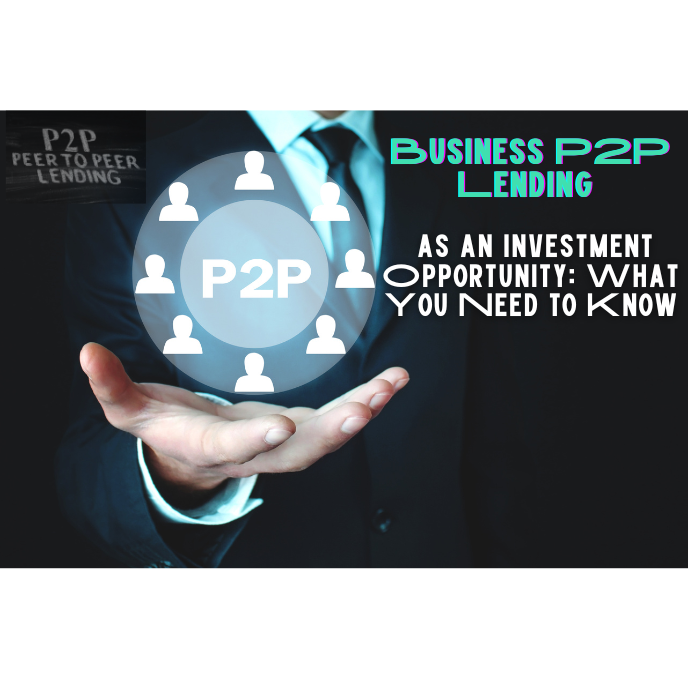Business P2P Lending as an Investment Opportunity: What You Need to Know

Introduction: Exploring Business P2P Lending
Peer-to-peer lending, where individuals lend to businesses via an intermediary platform, offers an exciting frontier in investment. This new form of lending, hereafter called business P2P lending, reshapes the financial landscape with its progressive model. Key stakeholders come together on the platform, operating outside traditional financial institutions, creating potentially lucrative investment opportunities. With an understanding of business P2P lending, its participants, and process, you will be well-equipped to explore its profitability potential. This post will delve into these aspects and more, highlighting the unique investment appeal P2P lending presents.
Unmasking Business Peer-to-Peer Lending
Business Peer-to-Peer (P2P) lending involves a fundamental process wherein lenders and borrowers interact directly through established platforms. Key stakeholders in this system are not limited to investors and borrowers. Indeed, these platforms themselves, lending facilitators, as well as regulatory bodies play significant roles. P2P lending businesses dissect traditional banking structures, allowing for direct transactions and thus fostering an accessible, efficient, and transparent financial landscape, revolutionizing the way businesses are funded.
Why Choose Business P2P Lending as an Investment?
Business Peer-to-Peer (P2P) lending stands out as a viable investment opportunity for several reasons. Its advantages include potentially high returns on investments due to the high-interest rates that P2P borrowers often agree to. The direct involvement of investors in the process and the ability to select specific businesses for lending contributes to the appeal. Additionally, the influx of institutional investors into this space is a testament to its growth potential and validity as an investment choice.
The Fascinating Growth of the P2P Lending Market
The P2P lending market has exhibited impressive growth. Historically, remarkable performance trends indicate that factors such as technological innovation, regulatory adjustments, and changing consumer preferences have been instrumental in propelling this market forward. Expert projections, based on robust analysis of existing market dynamics and technological advancements, suggest a bright future with significant growth potential for P2P lending. This buoyant optimism parallels the broader fintech sector’s momentum, underscoring the exciting investment opportunities in P2P lending.
Understanding the Mechanism of P2P Business Lending
In peer-to-peer business lending, the process begins with the application and ends with fund dispersion. The lending platform undertakes a thorough risk assessment and vets potential borrowers, establishing their creditworthiness. Based on this, the interest rate is fixed, and the loan terms discussed. Throughout the duration of the loan, repayments are made according to an agreed method, often directly to investors, leading to their returns. It’s an intricate process that combines the determination of financial integrity with calculated risk.
Dissecting the Risk in Business Peer-to-Peer Lending
Investing in business Peer-to-Peer lending is not without its risks. Default risk runs high, particularly if the borrower cannot repay its loan, causing substantial losses to investors. Additionally, market risks surround this investment aspect, including fluctuating economic conditions, policy adjustments, and technological innovations. Such factors can significantly impact the P2P lending industry, sometimes leading to unexpected losses for investors engaged in it. Understanding these risks is essential for strategic and sound investment decision-making in business peer-to-peer lending.
The Profitability Potential of P2P Business Lending
Profitability in P2P business lending is showcased through numerous case studies reflecting impressive returns on investments. Investors leveraging effective investment strategies have maximized their profitability. For instance, deliberately diversifying portfolios across various sectors, high-rated borrowers, and different loan durations. As reported by Deloitte, average annual returns could reach as high as 12% which substantiates the potential profitability of P2P business lending. Therefore, strategic investment in P2P lending can certainly yield substantial returns, making it a profitable option to consider.
How to Get Started with Business P2P Lending
Starting your journey in business P2P lending involves careful research to find a reputable lending platform. It’s crucial to social proof platforms through reviews and testimonials, checking their track record over time. Equally important is understanding your personal risk tolerance and investment objectives, as this market is not void of risk. Seek counsel, if needed, to ensure that your investment aligns with your overall financial goals before you start investing in peer-to-peer lending, it also promotes informed decision making.
The Regulatory Landscape for Business P2P Lending
Business peer-to-peer (P2P) lending is subject to a regulatory framework composed of both federal and state policies. Regulatory bodies like the Consumer Financial Protection Bureau (CFPB) and the Securities and Exchange Commission (SEC) play a crucial role, influencing the operations and structure of the P2P lending model. These agencies, along with state-specific laws, provide the guidelines for how P2P businesses can operationally function while preserving consumer rights and maintaining financial stability.
Diversification and Risk Management in P2P Lending
In peer-to-peer lending, diversification is crucial for risk management. By spreading investments across various loans, investors can mitigate potential losses, ensuring no single default significantly impacts their entire portfolio. Some investors opt for auto-invest systems that automatically diversify their investments. Still, others take a more hands-on approach by manually selecting loans based on their risk assessment. Whichever method chosen, it’s vital to have a balanced portfolio that matches the investor’s risk tolerance, ultimately maximizing returns while minimizing potential losses.
Common Challenges in Business Peer-to-Peer Lending
Business Peer-to-Peer (P2P) lending brings certain hurdles that need tackling. Identifying these roadblocks is the starting step in devising effective solutions and proactive strategies to overcome them. Common barriers are related to risk management, such as borrower defaults and market volatility. Balancing these risks can be challenging and unpredictable due to economic changes and regulatory modifications. For example, a sudden shift in trade policies may significantly alter the market, affecting the investment. However, with strategic risk mitigation methods, these challenges can be effectively managed.
Emerging Trends in Business P2P Lending
Recent advancements in the P2P lending sector are transforming how investors approach this platform. Innovations like more rigorous predictive modelling for credit risk evaluation and the integration of artificial intelligence in borrower assessment are making the platform even more attractive to investors. These recent developments do not only streamline the lending process but also potentially minimize risk, allowing investors to make more informed and potentially profitable decisions. Investors should stay updated with these changes to harness their full potential in the P2P lending market.
The Role of Technology in P2P Business Lending
Technology plays a critical part in P2P business lending, particularly in terms of platform integration. Lending platforms now employ seamless interfaces and user experiences that optimize the process, saving lenders and borrowers both time and money. Even more impressive is the role of artificial intelligence and machine learning. Through predictive algorithms, lenders can gauge a borrower’s credibility with higher precision, reducing default risk. For example, Upstart, a popular P2P platform, successfully reduced loan default rates by utilizing an AI model that improves underwriting decisions.
Investor Tips for Successful P2P Business Lending
To excel as a peer-to-peer lender in the business sector, it’s crucial to examine key aspects of potential investments. A few best practices can guide your decision-making process: anticipate and understand your investment’s risk versus reward ratio, scrutinize the borrower’s credibility and financial stability, and align your investment choices with your financial goals and risk tolerance. Remember, the secret to profitability in P2P business lending lies in meticulous analysis and informed investments. By adhering to these principles, you can potentially reap substantial profits from your P2P lending ventures.
Balancing the Pros and Cons of Business P2P Lending
When investing in business P2P lending, a fair evaluation of its pros and cons is essential. On one hand, P2P lending can offer attractive returns and direct access to a growing market. However, downside risks, such as borrower defaults, cannot be overlooked. Therefore, investors should diligently consider the potential profit versus risk and make informed decisions. For example, a well-diversified investment portfolio can help mitigate undue exposure to defaults, making this investment strategy thoughtful and balanced.
Case Study: Success Stories in P2P Business Lending
Looking at successful peer-to-peer (P2P) business lending scenarios is enlightening to potential investors. One noteworthy case is Lending Club, which has facilitated over $50 billion in loans and generated solid returns for lenders. Similarly, Prosper Marketplace boasts an average annual return of 5.3% for its investors. The key takeaway from these success stories is that diligent research, understanding of the market, and adherence to risk management principles can lead to substantial profits in P2P business lending.
Crystal-gazing the Future of Business P2P Lending
The future of business Peer-to-Peer lending seems poised for exciting transformations. Discernible trends suggest a vibrant future, with potential shifts set to influence the strategic investments by stakeholders. Key predicted shifts in P2P banking, such as integration of advanced technology for borrower vetting and fund dispersion, will hold significant implications for both investors and stakeholders alike. Consequently, being aware of these impending changes can serve to optimize investments and ensure a robust and diverse future portfolio for P2P lending market stakeholders.
Conclusion: Is Business P2P Lending a Good Investment?
Given the potential for rewarding returns and increasing market growth, business P2P lending presents a compelling investment. However, the associated risks, regulatory implications, and diversified strategies needed underscore its complexity. It might not suit all investor profiles. A keen understanding of the market, calculated risk tolerance, and strategic decision-making are crucial. Nevertheless, with its transformative potential and growing stature in finance, it certainly warrants further exploration for prospective investors.





